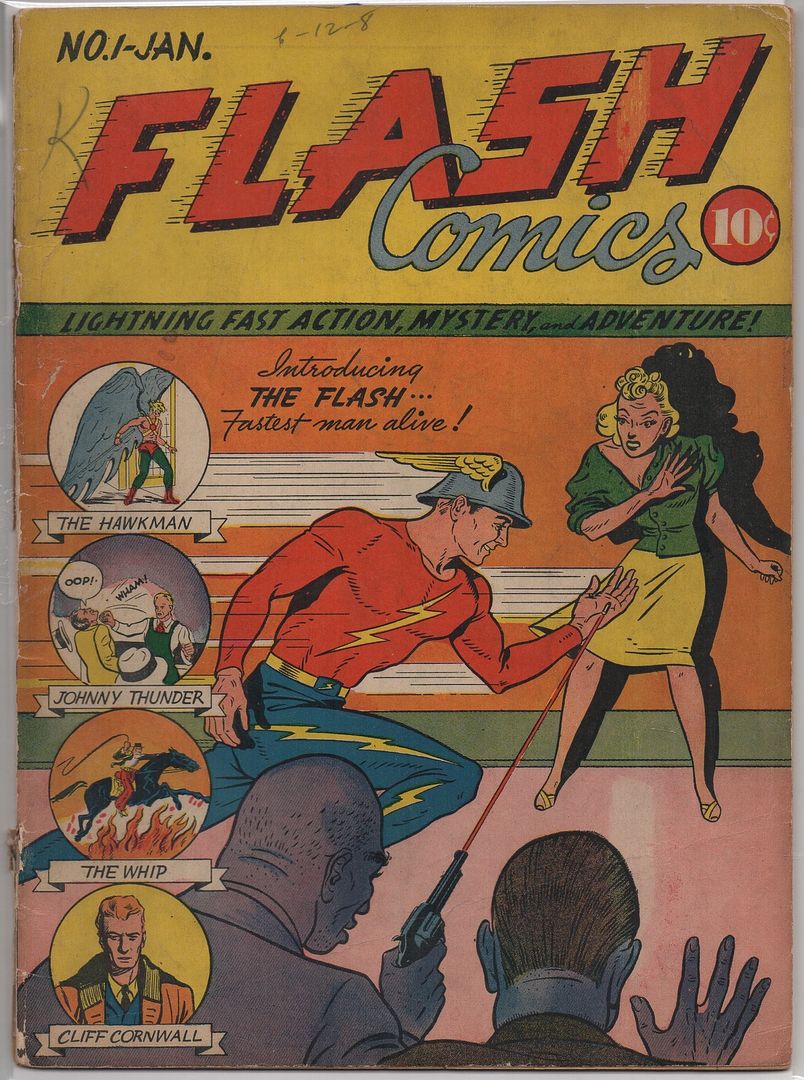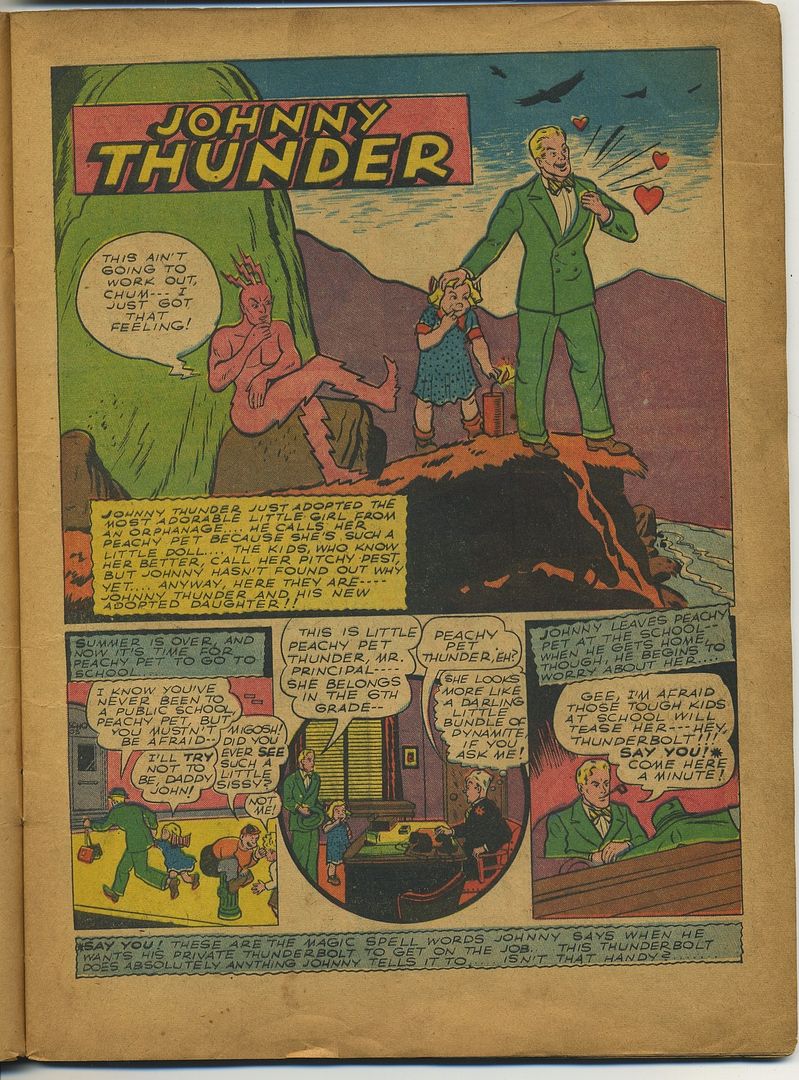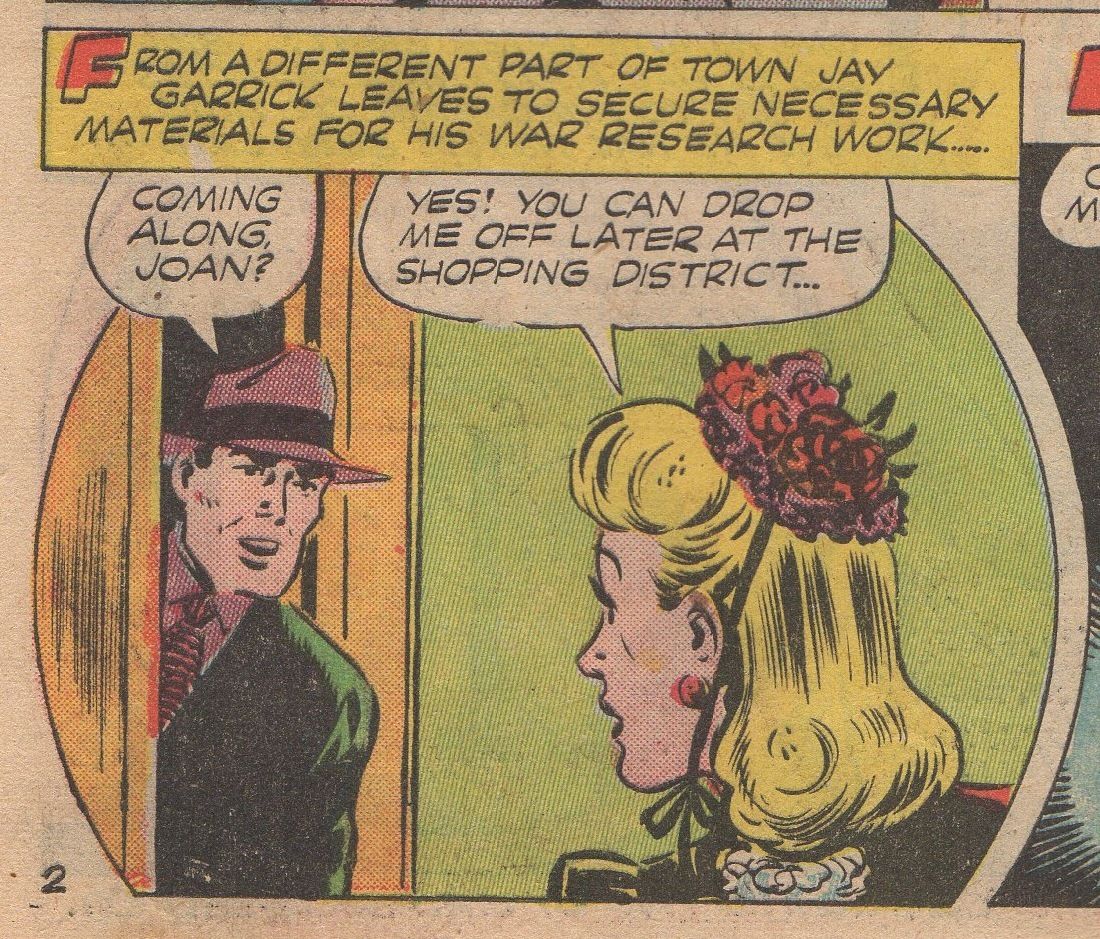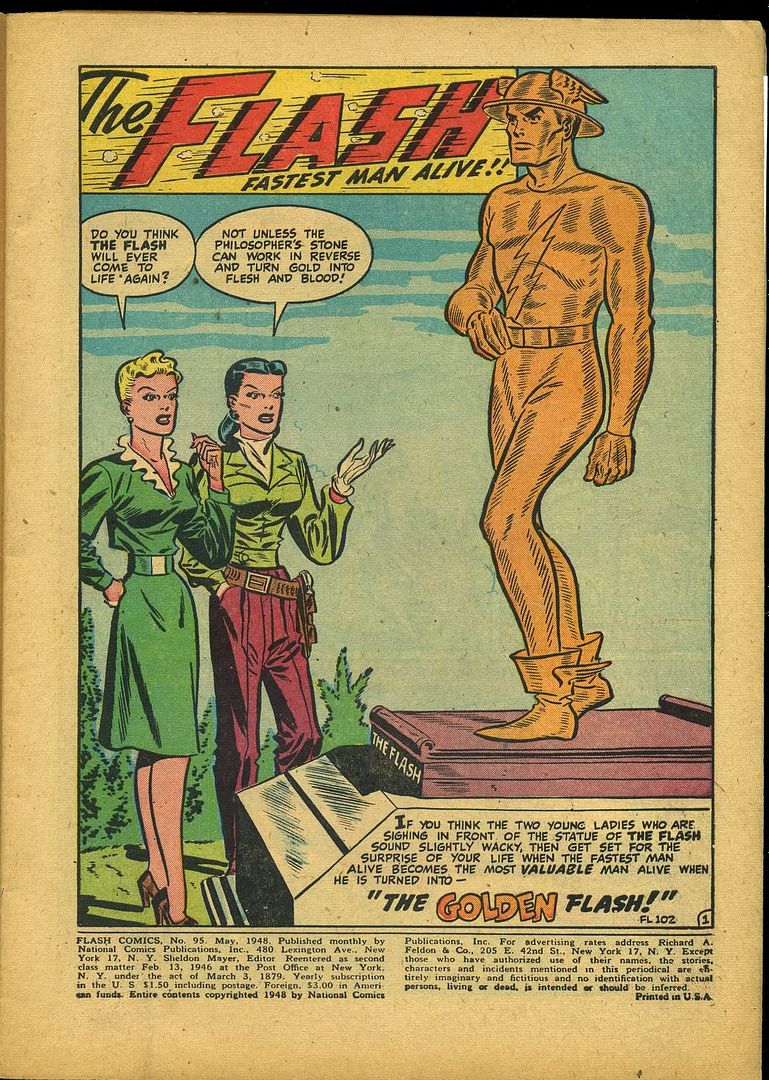Monday, December 31, 2012
Before I proceed with the review of the issues, a note about the grading system.
The 5 star system is broken down into the following triads:
Flash Story - 2 star maximum.
Hawkman Story - 2 star maximum.
Backup Stories - 1 star maximum.
Hence, if the Flash\Hawkman stories are well written and the art is good, they will receive a 2 star rating respectively. If the backup stories are entertaining enough that I actually read them and didn't find myself fidgeting to get past them, they collectively get a 1 star rating.
Most issues I found entertaining through out and received 5 stars.
Saturday, December 22, 2012
Entry #6
Other DC Comics with a January 1940 cover date:
Action Comics #20
Adventure Comics #46
All-American Comics #10
Detective Comics #35
Double Action Comics #2
More Fun Comics #51
Superman #3
Flash Comics #1
FIRST STORY
(Origin of the Flash) (15 pages)
Synopsis:
Jay Garrick, student at Midwestern University, is involved in a lab accident and inhales the fumes of hard water gas. The fumes cause Jay to develop tremendous speed, enabling him to move and think at super-human rates.
Jay graduates from college and moves to New York to become an assistant professor at Coleman University. There, he begins a career as the Flash, a super-hero who battles gangsters.
Jay’s college sweetheart, Joan Williams, visits Jay and enlists his help in locating her missing father. Joan’s father, Major Williams, has been kidnapped by the Faultless Four, a group of scientists working for a foreign power. Jay rescues Williams from the villains who want the secret of the Atomic Bombarder. In the process, the Four are all killed, leaving Williams safe.
THIRD STORY
(The Origin of Hawkman) (12 pages)
Synopsis:
Weapons collector Carter Hall receives an Egyptian dagger from his friend, Jim Rock. Touching the dagger causes Hall to relive his former life as Prince Khufu in ancient Egypt.
Khufu and his love, Shiera, are both killed with the dagger by Khufu’s longtime enemy, Hath-Set. At the moment of his death, Khufu promises to be reincarnated in order to avenge his own murder.
Carter awakens from the experience with knowledge of his previous unknown life. Soon after he meets Shiera for the first time fleeing a subway accident. Shiera has been plagued by dreams of her previous life as well.
Carter then fashions wings and a belt of ninth metal, an anti-gravity material with special properties. He also dons a hawk-shaped headpiece to appear as the Hawk-God Anubis. As Hawkman, he sets out to find the source of the subway disturbance.
Hawkman soon locates the laboratory of Doctor Hastor, electrician extraordinary. Hall realizes that Hastor is the reincarnation of his ancient foe, Hath-Set.
After a short battle, Hastor summons Shiera using a strange hypnosis to use against Hawkman. The winged hero throws a protective sheet of ninth metal over Shiera to protect her, then shoots Hastor with a crossbow. Hastor appears to die and the laboratory is destroyed. Finally, Hawkman returns Shiera to her home.
Sunday, December 16, 2012
Flash Comics Collection #70-104
My Flash Comics Collection flipped to Helen Carroll & Satisfiers - 'Ole Buttermilk Sky' and Vaughn Monroe - 'Who Told You That Lie?' (1946)
Flash Comics Collection #40-69
My Flash Comics Collection flipped to Dick Robertson's "We Did It Before (And We Can Do It Again)" (1941)
Saturday, December 15, 2012
Flash Comics Collection #1-#39
Here is my Flash Comics Collection. Issues 1 thru 39. Flipped to Barry Wood's 'Any Bonds Today' (1941).
Saturday, December 8, 2012
Newsreel Entry #2
The Winter War was a military conflict between the Soviet Union and Finland. It began with a Soviet offensive on 30 November 1939 -- two months after the start of World War II and the Soviet invasion of Poland -- and ended on 13 March 1940 with the Moscow Peace Treaty.
provided by curiosity of WirbelwindStudios youtube channel.
Music Entry: 11/39b
Do I Love You? (Porter) by Leo Reisman & His Orchestra, vocal by Lee Sullivan.
Recorded November 25, 1939.
provided by curiosity of MusicProf78 youtube channel.
Saturday, December 1, 2012
Entry #5
Splash Page from Flash Comics #22
Johnny Thunder
John L. Thunder was born in the Bronx on July 7, 1917, a Saturday – the seventh day of the seventh month in a year ending in a seven, on the seventh day of the week. This coincided with the Seventh Circle of the Moon Lashseen in the calendar of the small Asian country of Badhnisia. Knowing that this would give such a child great potential, the High Priest of Aissor sent agents to kidnap a child born at that time.
Disguised by having his hair and skin darkened, Johnny was spirited away to Badhnisia. There was a ceremony in which a belt bearing the Eternal Zone of the Zodiac was placed on him and the secret words "Cei-U" (pronounced "Say You") spoken seven times. The spell thus cast would take effect on the child’s seventh birthday.
But the neighboring nation of Agolea learned of the child who would one day have the power to conquer the world and launched a war to capture him. The High Priest had Johnny taken by a nurse to a hiding place in a fishing village north of Brunei, Borneo. One day he slipped away and was playing in a small boat when the tides and winds took him out to sea. He was picked up by an American freighter that brought him to New York. There he was identified by a strawberry mark on his left shoulder and returned to his parents (who by now had two younger children).
During the week of his seventh birthday, torrential rains fell all over the world – except on the Thunder home. The High Priest knew this meant that Johnny (who still wore the Zodiac Belt), now had the power. He sent agents to abduct him, but by then Simon Thunder had moved and changed jobs. They didn’t find Johnny until 1939, when he was 22. Though he didn’t yet know it, he could command a magic Thunderbolt.
With his power, Johnny became Heavyweight Champ, but vacated the title to please his girl, Daisy Darling.
His one-day career as a rodeo rider was at Madison Square Garden, when he saved the life of a little blond orphan girl who fell in the path of a rampaging steer. Soon after, he adopted the girl, named Peachy Pet.
Johnny was present at the first meeting of the Justice Society of America and became a sort of mascot – until the Flash resigned his active membership and Johnny was chosen to replace him. During World War II, Johnny joined the U.S. Navy.
When the conflict ended, Johnny was 28 (4 x 7) – a power high. Thus the High Priest waited a year, then cast a spell that gradually reduced the hero’s power over the Thunderbolt, till he was only answering about one call in four. This caused Johnny to resign from the JSA, to be replaced by his friend the Black Canary, whom he had a crush on.
Finally, Johnny’s power vanished entirely. By this time, the King of Badhnisia was dying. The High Priest had Johnny abducted again and cast a spell that forced him to obey the priest’s commands and forbade him to use the Thunderbolt against him. Only then did he restore the power. And when the King died, Johnny was placed on the throne, and the High Priest announced his plans for world conquest.
But Johnny found an out. He sent the Thunderbolt for Superman, who, with the aid of his wife, Lois, overcame the priest. Johnny remained in Badnisia to teach the people about democracy. When their first President was elected, he returned home.
What happened to the Zodiac Belt has not been determined.
POWERS AND WEAPONS
When he speaks the words "Say You" (Cei-U), Johnny has absolute power over the genie-like Thunderbolt (who is smarter than Johnny) for one hour.
Johnny Thunder
John L. Thunder was born in the Bronx on July 7, 1917, a Saturday – the seventh day of the seventh month in a year ending in a seven, on the seventh day of the week. This coincided with the Seventh Circle of the Moon Lashseen in the calendar of the small Asian country of Badhnisia. Knowing that this would give such a child great potential, the High Priest of Aissor sent agents to kidnap a child born at that time.
Disguised by having his hair and skin darkened, Johnny was spirited away to Badhnisia. There was a ceremony in which a belt bearing the Eternal Zone of the Zodiac was placed on him and the secret words "Cei-U" (pronounced "Say You") spoken seven times. The spell thus cast would take effect on the child’s seventh birthday.
But the neighboring nation of Agolea learned of the child who would one day have the power to conquer the world and launched a war to capture him. The High Priest had Johnny taken by a nurse to a hiding place in a fishing village north of Brunei, Borneo. One day he slipped away and was playing in a small boat when the tides and winds took him out to sea. He was picked up by an American freighter that brought him to New York. There he was identified by a strawberry mark on his left shoulder and returned to his parents (who by now had two younger children).
During the week of his seventh birthday, torrential rains fell all over the world – except on the Thunder home. The High Priest knew this meant that Johnny (who still wore the Zodiac Belt), now had the power. He sent agents to abduct him, but by then Simon Thunder had moved and changed jobs. They didn’t find Johnny until 1939, when he was 22. Though he didn’t yet know it, he could command a magic Thunderbolt.
With his power, Johnny became Heavyweight Champ, but vacated the title to please his girl, Daisy Darling.
His one-day career as a rodeo rider was at Madison Square Garden, when he saved the life of a little blond orphan girl who fell in the path of a rampaging steer. Soon after, he adopted the girl, named Peachy Pet.
Johnny was present at the first meeting of the Justice Society of America and became a sort of mascot – until the Flash resigned his active membership and Johnny was chosen to replace him. During World War II, Johnny joined the U.S. Navy.
When the conflict ended, Johnny was 28 (4 x 7) – a power high. Thus the High Priest waited a year, then cast a spell that gradually reduced the hero’s power over the Thunderbolt, till he was only answering about one call in four. This caused Johnny to resign from the JSA, to be replaced by his friend the Black Canary, whom he had a crush on.
Finally, Johnny’s power vanished entirely. By this time, the King of Badhnisia was dying. The High Priest had Johnny abducted again and cast a spell that forced him to obey the priest’s commands and forbade him to use the Thunderbolt against him. Only then did he restore the power. And when the King died, Johnny was placed on the throne, and the High Priest announced his plans for world conquest.
But Johnny found an out. He sent the Thunderbolt for Superman, who, with the aid of his wife, Lois, overcame the priest. Johnny remained in Badnisia to teach the people about democracy. When their first President was elected, he returned home.
What happened to the Zodiac Belt has not been determined.
POWERS AND WEAPONS
When he speaks the words "Say You" (Cei-U), Johnny has absolute power over the genie-like Thunderbolt (who is smarter than Johnny) for one hour.
Friday, November 30, 2012
Entry #4
In the days of ancient Egypt, Prince Khufu was the foe of the high priest of the god Anubis, Hath-Set, who intended to conquer the world. Hath-Set’s soldiers captured Khufu and his beloved, Shiera, and Hath-Set fatally stabbed Khufu. Before his death, Khufu predicted that both he and Hath-Set would one day live again, and that next time Khufu would be the victor.
Many centuries later, the wealthy scientist Carter Hall came into the possession of the very knife with which Khufu had been murdered. Hall then had a dream about Khufu’s death and realized that he was Khufu’s reincarnation. Shortly afterwards, Hall first met Shiera Sanders, the reincarnation of Khufu’s beloved. Hath-Set also had been reincarnated, as the scientist Dr. Anton Hastor, and still planned to conquer Earth.
Hall garbed himself in the guise of the Egyptian hawk-god, including large artificial wings and a belt of "ninth metal," a discovery of Hall’s that could defy gravity. Using the belt and wings, Hall could fly. As Hawkman, Hall tracked down Hastor and prevented him from killing Shiera. Hastor apparently died, but he later returned to battle Hawkman again.
Hawkman launched a career as a super-hero, and Shiera became his partner as Hawkgirl. A founding member of the Justice Society of America, Hawkman became its third chairman, a position he has held ever since. He was also a member of the war-time All-Star Squadron.
In 1946 Hawkman discovered Feithera, a hidden city of bird-people in Greenland. He became a frequent visitor there, and he and Hawkgirl became the godparents of Norda, now known as the super-hero Northwind, who is the son of a human and a Feitheran.
Hawkman and Hawkgirl both retired after the Justice Society disbanded in 1951. Hall married Shiera, and they had a son, Hector, who later became the super-hero known as the Silver Scarab. Hall returned to his career as Hawkman when the Justice Society was reactivated, and he serves as its chairman to this day. His true identity is now publicly known.
POWERS AND WEAPONS
Hawkman can fly at great speed using artificial wings and an anti-gravity belt made of "ninth metal." The belt also enables him to lift great weights aloft. In addition, he wields ancient and medieval weapons from his extensive collection in battle and can communicate with birds.
Hawkman is a superb hand-to-hand combatant. He retains unusual physical vitality even today, thanks to having absorbed temporal energy from the villainous Ian Karkull decades ago.
(reprinted from various internet sources)
Many centuries later, the wealthy scientist Carter Hall came into the possession of the very knife with which Khufu had been murdered. Hall then had a dream about Khufu’s death and realized that he was Khufu’s reincarnation. Shortly afterwards, Hall first met Shiera Sanders, the reincarnation of Khufu’s beloved. Hath-Set also had been reincarnated, as the scientist Dr. Anton Hastor, and still planned to conquer Earth.
Hall garbed himself in the guise of the Egyptian hawk-god, including large artificial wings and a belt of "ninth metal," a discovery of Hall’s that could defy gravity. Using the belt and wings, Hall could fly. As Hawkman, Hall tracked down Hastor and prevented him from killing Shiera. Hastor apparently died, but he later returned to battle Hawkman again.
Hawkman launched a career as a super-hero, and Shiera became his partner as Hawkgirl. A founding member of the Justice Society of America, Hawkman became its third chairman, a position he has held ever since. He was also a member of the war-time All-Star Squadron.
In 1946 Hawkman discovered Feithera, a hidden city of bird-people in Greenland. He became a frequent visitor there, and he and Hawkgirl became the godparents of Norda, now known as the super-hero Northwind, who is the son of a human and a Feitheran.
Hawkman and Hawkgirl both retired after the Justice Society disbanded in 1951. Hall married Shiera, and they had a son, Hector, who later became the super-hero known as the Silver Scarab. Hall returned to his career as Hawkman when the Justice Society was reactivated, and he serves as its chairman to this day. His true identity is now publicly known.
POWERS AND WEAPONS
Hawkman can fly at great speed using artificial wings and an anti-gravity belt made of "ninth metal." The belt also enables him to lift great weights aloft. In addition, he wields ancient and medieval weapons from his extensive collection in battle and can communicate with birds.
Hawkman is a superb hand-to-hand combatant. He retains unusual physical vitality even today, thanks to having absorbed temporal energy from the villainous Ian Karkull decades ago.
(reprinted from various internet sources)
Saturday, November 24, 2012
Entry #3
For those unfamiliar with the series, as I was just a couple years ago, I would like to introduce some of the many characters that appeared in the Flash Comics series throughout the decade (reprinted from various internet sources).
Jay Garrick (the Flash)
Jay Garrick and his future wife, Joan Williams, were students at Midwestern University. One day while there, Garrick accidentally tipped over a beaker full of an experimental form of "hard water" he had been studying. The spilled liquid gave off fumes that rendered Garrick unconscious, and he lay inhaling the fumes all night. Afterward he discovered that the fumes had given him the power to move at superhuman speed. He became the costumed crimefighter known as the Flash. At first only Joan Williams knew that the Flash was really Jay Garrick. (Although Garrick wore no mask as the Flash, he maintained waves of vibrations over his face while he was in costume, thereby preventing anyone from clearly seeing his features.) The Flash became a founding and the first chairman of the Justice Society of America.
During the war, Jay work for the War Department was classified. This is a rare instance that he revealed any involvement with the war (Issue #48).
Garrick retired as the Flash in 1951 as a result of his refusal to reveal his true identity to a congressional committee. Eventually, he married Joan Williams. Years later Garrick resumed his career as the Flash as a result of meeting the Flash of a parallel world, and in order to battle his three old foes the Fiddler, Shade, and Thinker. The original Flash also returned to service with the reactivated Justice Society, and in recent years has publicly revealed his true identity.
POWERS AND WEAPONS
The Flash possesses the power to move at superhuman speed, and can attain velocities equal to that of the speed of light (186,000 miles per second). His superhuman endurance enables him to run great distances without tiring. The Flash’s endurance has diminished somewhat with age, although, due to the effects of the temporal energy he absorbed from the villainous Ian Karkull, he retains far more physical vitality than he otherwise would.
The Flash possesses an aura of unknown energy that protects him from friction heat and the other adverse effects of movement at super-speed.
The Flash also has absolute mental control of his body’s atoms and molecules. He most often uses this power to vibrate his atoms at such high speeds that they can slip past atoms of solid object, enabling the Flash to pass through such objects without damaging them. He can also travel to other dimensions through varying the vibratory rate of his atoms. The Flash can also vibrate his clothing and even another human he is holding through a solid object or into another dimension with him.
Jay Garrick (the Flash)
Jay Garrick and his future wife, Joan Williams, were students at Midwestern University. One day while there, Garrick accidentally tipped over a beaker full of an experimental form of "hard water" he had been studying. The spilled liquid gave off fumes that rendered Garrick unconscious, and he lay inhaling the fumes all night. Afterward he discovered that the fumes had given him the power to move at superhuman speed. He became the costumed crimefighter known as the Flash. At first only Joan Williams knew that the Flash was really Jay Garrick. (Although Garrick wore no mask as the Flash, he maintained waves of vibrations over his face while he was in costume, thereby preventing anyone from clearly seeing his features.) The Flash became a founding and the first chairman of the Justice Society of America.
During the war, Jay work for the War Department was classified. This is a rare instance that he revealed any involvement with the war (Issue #48).
Garrick retired as the Flash in 1951 as a result of his refusal to reveal his true identity to a congressional committee. Eventually, he married Joan Williams. Years later Garrick resumed his career as the Flash as a result of meeting the Flash of a parallel world, and in order to battle his three old foes the Fiddler, Shade, and Thinker. The original Flash also returned to service with the reactivated Justice Society, and in recent years has publicly revealed his true identity.
POWERS AND WEAPONS
The Flash possesses the power to move at superhuman speed, and can attain velocities equal to that of the speed of light (186,000 miles per second). His superhuman endurance enables him to run great distances without tiring. The Flash’s endurance has diminished somewhat with age, although, due to the effects of the temporal energy he absorbed from the villainous Ian Karkull, he retains far more physical vitality than he otherwise would.
The Flash possesses an aura of unknown energy that protects him from friction heat and the other adverse effects of movement at super-speed.
The Flash also has absolute mental control of his body’s atoms and molecules. He most often uses this power to vibrate his atoms at such high speeds that they can slip past atoms of solid object, enabling the Flash to pass through such objects without damaging them. He can also travel to other dimensions through varying the vibratory rate of his atoms. The Flash can also vibrate his clothing and even another human he is holding through a solid object or into another dimension with him.
Friday, November 16, 2012
Entry #2
What got me interested in Flash Comics? I grew up on Bronze Age DCs. Also ‘Conan The Barbarian’ had a sway on this once skinny boy envious of the all the interest girls shown the bigger boys. I was introduced to Flash Comics through the CGC GA boards. My first purchase was #40.
I like the series because it represents the early days of the pre-hero DC universe with the back-up stories, along with ‘new’ superhero characters the Flash and the Hawkman. Unlike Superman and Batman, these superheroes have private lives that they share with their female companions, and occasionally with old friends. As a plot devise, this frees Gardner Fox from the obstacles that at times makes Superman and Batman stories redundant. World events creep into the stories – although it isn’t until 1944 that both the Flash and Hawkman hints at a world at war in their regular monthly strips.
The backup stories like Johnny Thunders and the Ghost Patrol are lighthearted comedic adventures that can be enjoyable to read. Like the Sunday Funnies section of old, to read Flash Comics is similar in that each story has a distinct flow to it, month-after-month. It was after reading about three or four issues that I got curious to learn more about DC Comics during the 1940s.
By the end of the decade, Flash, Hawkman, and Black Canary gives us glimpses of what Silver Age superheroes will look\feel like in the future. It seems odd after reading the last 12 issues of the series why it ended. Those are some of the best issues of the whole series.
Saturday, October 27, 2012
Newsreel Entry #1
Flash Comics made its debut on 10 November 1939. Here is the house ad from Adventure Comics #45:
For a historical perspective, I've added a newsreel from September 1939 as the Germans invaded the Danzig Post Office Building.
Newsreel courtesy of youtube channel: bagnowka7
Music Entry: 11/39a
All The Things You Are by Frankie Masters & his Orchestra
vocal by Harlan Rogers.
Recorded November 7, 1939.
provided by curiosity of MusicProf78 youtube channel.
Entry #1
The ‘Flash Comics Journal’ is dedicated to the 104 issues of DC
comics that ran from the fall of 1939 thru the spring of 1948. Covering
the dawn of the Superhero phenomenon and leading towards its decline and
near extinction.
The reason why I like to collect golden age comics, in particular Flash Comics, is that they allow me to forget about my middle-aged physical pains, mundane daily tasks – cleaning up after two little boys, and mentally draining responsibilities of maintaining an internet business. Comics back in 1940 offered a way to cope with the real world threat to our countries very survival. They also served as the ethical handbook of what Right was and how to avoid the Wrong. Holding a golden age comic book in my hands allows me to leave modernity and teleport on a zeta beam into a fantastical world where no matter what strange things occur, there will be a favorable resolution. Seventy years removed from the real world threats facing the USA – and in particular, the mind of an adolescent – these stories are fun to read. It is also is a great joy to watch the art evolve over the course of the decade.
My opinion of comic books as a collectible is that Action Comics #1 is the Golden Calf in the pantheon of American Mythology. As the gods of America cease into oblivion with the decline of 'Truth, Justice, and the American Way' – or until rising sea levels engulf most of the east coast, the aesthetic value of the whole genre of comic books collectibles will continue to appreciate.
OK . . . enough with the talk, where is the group shot???
Here is a small sampling of what is to come:
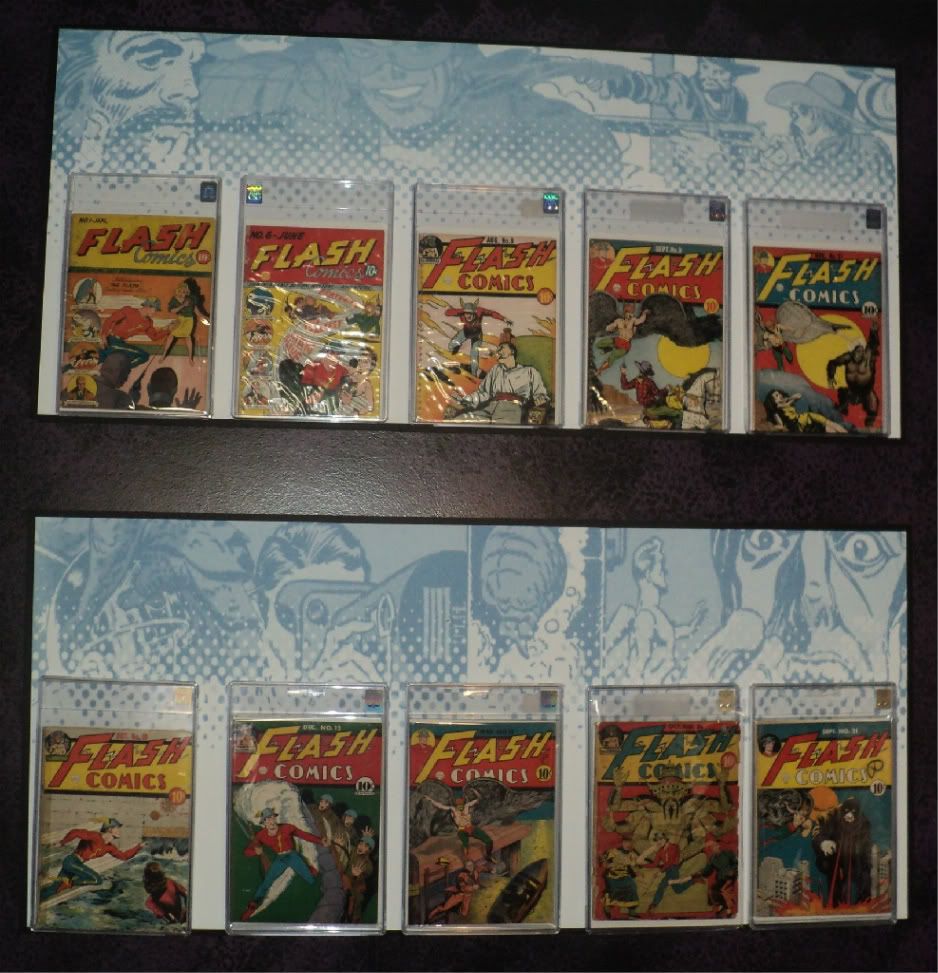
The reason why I like to collect golden age comics, in particular Flash Comics, is that they allow me to forget about my middle-aged physical pains, mundane daily tasks – cleaning up after two little boys, and mentally draining responsibilities of maintaining an internet business. Comics back in 1940 offered a way to cope with the real world threat to our countries very survival. They also served as the ethical handbook of what Right was and how to avoid the Wrong. Holding a golden age comic book in my hands allows me to leave modernity and teleport on a zeta beam into a fantastical world where no matter what strange things occur, there will be a favorable resolution. Seventy years removed from the real world threats facing the USA – and in particular, the mind of an adolescent – these stories are fun to read. It is also is a great joy to watch the art evolve over the course of the decade.
My opinion of comic books as a collectible is that Action Comics #1 is the Golden Calf in the pantheon of American Mythology. As the gods of America cease into oblivion with the decline of 'Truth, Justice, and the American Way' – or until rising sea levels engulf most of the east coast, the aesthetic value of the whole genre of comic books collectibles will continue to appreciate.
OK . . . enough with the talk, where is the group shot???
Here is a small sampling of what is to come:

Subscribe to:
Posts (Atom)

